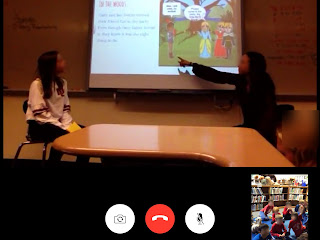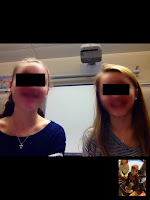There are plenty of wonderful coding apps and websites out there for elementary school students. Common sense media has a great list for students ranging from 5+ to 15+ on their website. Code.org has excellent resources for introducing both plugged and unplugged coding activities, and taps into student interest with Minecraft and Star Wars themed tutorials with their Hour of Code. With all the choices out there, it can be overwhelming to pick a programming language or tutorial to begin with. What is best for you and your students depends on your own unique needs and goals. For our library learning commons, that means we will be introducing the free app Scratchjr to our K-2 students. Here's why:
Scratchjr goes beyond introducing the concepts of coding to early readers, by empowering students to share their learning, and create and publish their own interactive multimedia projects.
My after school K-2 Code Club students creating their own games and videos with Scratchjr
Unlike some of the other drag-and-drop block coding apps and websites designed for K-2 students, Scratchjr really does require some pre-teaching and direct instruction before the students can run with it. However, once the students understand the basic concepts and become familiar with the graphical programming blocks, they become empowered to create and express themselves. The opportunities to tie Scratchjr into the general curriculum and Common Core are endless.
Jacob Lee (@TeachingJake), a first grade teacher, has posted some amazing Scratchjr videos designed by his students, in which they use their knowledge of programming to tell personal narratives, and even share their understanding of math and science concepts.
Jacob Lee's 1st grade students sharing their understanding of subtraction
With Scratchjr, you are really hitting the top of both the Bloom's pyramid and the SAMR model:
I have not yet introduced Scratchjr to my library students, however I have been running an 8 week after school session on Scratchjr with our K-2 students. During just 8 1-hour courses, our students were able to learn about and use almost every programming block. During this after school club of mixed grades, students were tasked to create their own interactive games and videos. Here are some examples of our students' work:
A Code Club student codes his own version of "Crossy Road"
A Code Club student codes a race
For teachers looking to get started with Scratchjr, I recommend the following resources:
Start unplugged with printed (or projected) scratch motion blocks. We had the students work in groups to program their friends' movements using printed cards with Scratchjr graphical blocks. We also used these blocks on the SMART Board for a teacher led "Programmer Says" Simon says game at the start of each class. We often introduced a new block of code to the class this way.
Our Code Club students programming their friends with Scratchjr cards
If you are pressed for time and cannot follow the extensive Scratchjr curricula, I recommend using their activities as a quick way of introducing new concepts in Scratchjr. We often began our classes with a new activity from this page, having the students follow along and replicate the same code on their iPads. This was sometimes a challenge as the Kindergarten students often needed more guidance than the 2nd graders. I had a co-teacher for this class, and typically one of us would instruct in front of the class, while the other assisted students in need. Afterwards, the students were challenged to use the new concepts to design their own original video or games.
Our code club students following along on a whole-class activity
Having taught the original web-based Scratch program to students in upper elementary and middle school, I was incredibly impressed by the Scrathjr spin-off for the younger users. We will be introducing Scratchjr to our K-2 library students this December, and plan to challenge students to share and express their learning in creative and new ways. More posts and updates on our journey with Scratchjr to follow!

